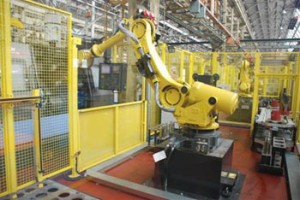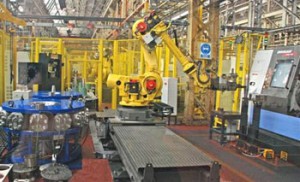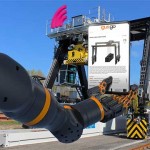Robots make early impact on MASS agreement at BAE Systems
A recently commissioned manufacturing facility for the machining of 105mm artillery shells has made an early impact on the aims of the MASS contractual partnership between BAE Systems and the UK MoD. MASS (Munitions Acquisition – the Supply Solution) –aims to deliver increased supplies of ammunition to front line troops by modernising and ensuring sustainability of the UK munitions industry.
Although due to be relocated to a brand new £28 million facility in Washington Co Durham, the recently installed manufacturing facility is currently operating at BAE Systems’ Birtley plant which dates back to 1916. Operating alongside an existing manually operated facility the new manufacturing cell removes operators from potentially hazardous areas, occupies a quarter of the space, requires 4 less operators per shift, has increased product quality and has increased available capacity.
The overall system comprises four separate robot controlled manufacturing cells capable of independent operation to allow maintenance and retooling to be undertaken without stopping production. The system is designed to manufacture both the 105mm and 155mm shell with quick changeover routines embodied into the manufacturing processes.
Cells one to three each have two Doosan Puma CNC machine centres, supplied by Mills CNC Ltd, the prime contractor, which provide a degree of flexibility dependent on production demand. Cell four has a single machine centre. Each cell has a FANUC Robotics R2000iB/175 robot loading machines and peripheral equipment.
Shells are progressively machined in each cell and transfer between cells is managed by outputting machined parts onto link conveyors designed by Ewab Engineering Group for collection by the FANUC Robotics robot in the next cell. LEAN manufacturing processes are employed to identify waste within the system and, to ensure the system will run continuously with planned stoppages, cells are linked with the smallest sized buffer conveyor possible.
 On receipt of order Mills CNC contracted complete system integration of equipment and communications to FANUC Robotics UK limited. Jeff Robson, MASS Transformation Engineer for BAE Systems Birtley, commented, “Machining the shells is the core process on this system so Mills, who had developed similar systems within BAE Systems, was the natural selection for prime contractor. The effective operation of this system has been a partnership between BAE Systems and all the suppliers involved. As the robots are central to handling product throughout the system FANUC Robotics expertise for cell and system integration was utilised.
On receipt of order Mills CNC contracted complete system integration of equipment and communications to FANUC Robotics UK limited. Jeff Robson, MASS Transformation Engineer for BAE Systems Birtley, commented, “Machining the shells is the core process on this system so Mills, who had developed similar systems within BAE Systems, was the natural selection for prime contractor. The effective operation of this system has been a partnership between BAE Systems and all the suppliers involved. As the robots are central to handling product throughout the system FANUC Robotics expertise for cell and system integration was utilised.
“Communications are enabled through I/O at machine level with Profibus enabling significant volumes of data to be collected for OEE (Overall Equipment Effectiveness) calculations and display of system performance through a large monitor.”
Advanced manufacturing software has allowed BAE Systems to develop and apply strict controls throughout the machining process and maintenance procedures – SMS messages and E Mail prompts are activated by the system to specific Team members to ensure required human intervention is prepared and made when needed.
The four R-2000iB robots each have specially engineered grippers designed by FANUC Robotics – these handle the shell either on its Outside Diameter or the fuse bore Internal Diameter. Each cell has peripheral equipment in the form of two way conveyors for inspection or additional process checking purposes.
Cells three and four both have marking systems developed by Pryor Ltd into which the cell robot positions and holds the shell as information, defined by process, is applied. One of these processes involves a shell weigh inspection operation with a pass fail decision needed.
One cell includes an advanced robotic flaw detect inspection system using Eddy current and phased array technologies supplied by NDT Ltd into which the cell robot loads and unloads machined shells. In another cell the robot picks and loads a driving band to a machined groove which is then pressed to fit in a two press operation designed by Orwin Ltd.
Linear rails are employed in two cells to enable the respective robots a greater working range to undertake additional processes and operations to maximise their potential. The rail units, engineered by FANUC Robotics, effectively make the robots seven axes units.
Jeff Robson continues, “Operator uptake and acceptance of the system has been excellent – we have a saying which we stick to when engineering any process ‘Simple’s best, simple’s easy and simple’s understood’ – this works for us as we avoid unnecessary complications so operators can take it over, monitor performance and invariably improve upon it using a PDCA (Plan, Do, Check, Act) philosophy!
“We are due to start to move to the new facility in September and this system is already effectively contributing to the efficient cost-down manufacture of munitions for the MoD.”
Visit the FANUC website for more information.
See all stories for FANUC.
















